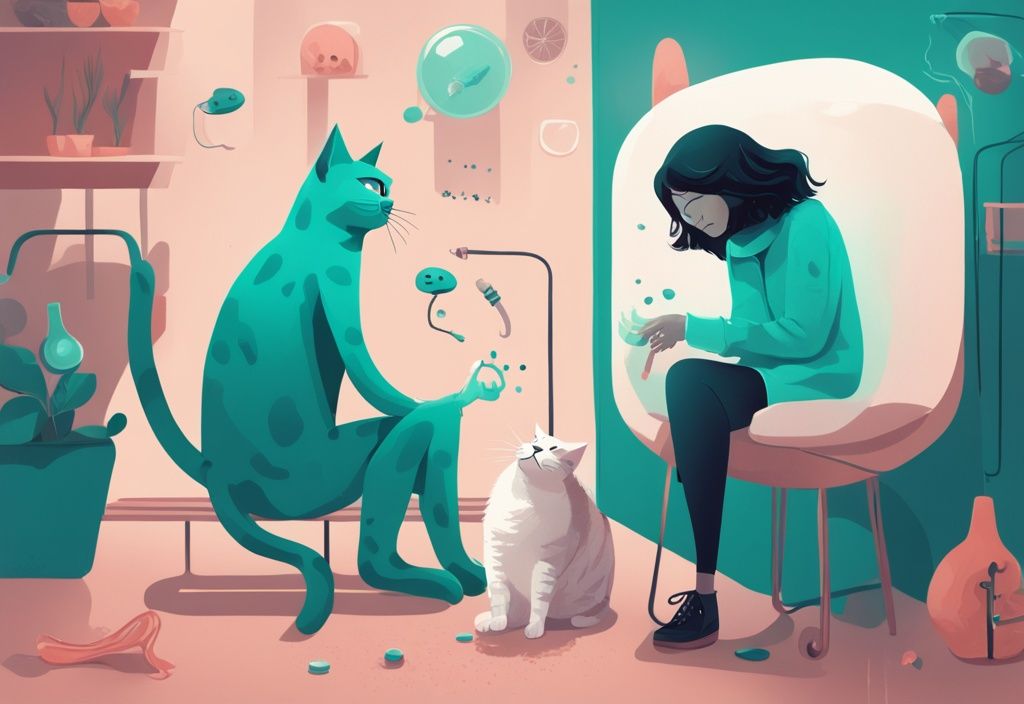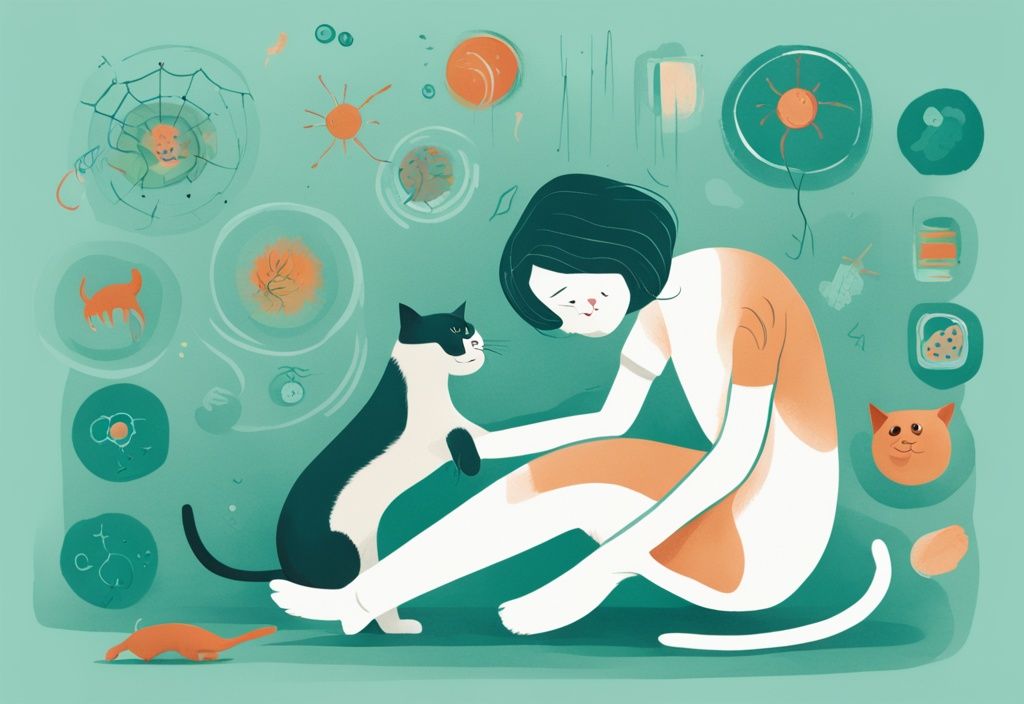Ever snuggled up with your purring kitty and wondered, “What diseases can I catch from my cat?” As a fellow cat lover, I’ve pondered this too! Cats, as adorable as they are, can sometimes carry diseases that may affect us humans. But don’t fret, knowledge is power, and I’m here to help you navigate this feline health maze.
In this article, we’ll explore the common diseases transmitted by cats, identify who’s most at risk, and discuss practical steps to protect you and your family. From bacterial infections like cat scratch disease to viral threats such as rabies, we’ll cover it all.
So, let’s dive in, shall we? After all, understanding these potential risks is the key to enjoying the companionship of your whiskered friend with peace of mind.
Common Diseases Transmitted by Cats
Ever wondered what diseases you might catch from your feline friend? Cats, with their mysterious charm and playful antics, can sometimes be carriers of diseases that may affect us humans. Let’s dive into the world of cat-related infections and explore what you need to know to keep both you and your furry companion healthy.
Bacterial Infections You Can Get from Cats
Cats can be adorable little bundles of joy, but did you know they can also carry some sneaky bacterial infections? One of the culprits is Cat Scratch Disease (CSD), caused by the bacterium Bartonella henselae. It’s usually transmitted through scratches, bites, or even a lick on an open wound. Imagine Whiskers giving you a playful swipe, and suddenly you’re dealing with swelling, fever, and fatigue. Not so fun, right? Another bacterial menace is Pasteurella multocida, lurking in those cute kitty mouths. If you get bitten, it can cause painful, swollen infections. And let’s not forget about Salmonellosis, which you might catch from handling cat feces, especially if your cat has indulged in some raw meat. This one brings on diarrhea and fever. Oh, and there’s Campylobacteriosis, another tummy trouble from cat feces. Lastly, we have the serious Methicillin-resistant Staphylococcus aureus (MRSA), which can jump from cats to humans, posing significant health risks.
Viral Diseases Cats Can Pass to Humans
Now, let’s talk about the big bad wolf of viral diseases—Rabies. It’s a rare but serious viral infection that can be transmitted through bites from infected cats. Picture this: a bite from an infected kitty, and you’re dealing with a disease that’s almost always fatal if untreated. Yikes! Thankfully, post-exposure prophylaxis (PEP) is like a superhero cape, swooping in to prevent rabies if you act fast.
Fungal Infections from Cats
Fungal infections might sound like something out of a fairy tale, but they’re very real. Take Ringworm, for instance. Despite its misleading name, it’s not a worm but a fungus that can leave you with red, itchy skin lesions. Then there’s Sporotrichosis, which can hitch a ride through scratches from an infected cat, leading to skin ulcers and lesions. Both of these require a bit of medical magic to clear up.
Parasitic Infections Linked to Cats
Ah, parasites—the uninvited guests of the pet world. Cats can host various parasites that might decide to pay you a visit. Fleas and ticks are the usual suspects, causing itching and inflammation. They might even bring along other diseases. And then there’s Scabies, courtesy of the Sarcoptes scabiei mite, which can lead to itchy skin lesions. Feline intestinal parasites like roundworms and hookworms are particularly fond of children. Hookworms can sneak through your skin, while roundworms might cause internal organ and eye infections. Oh, and if you accidentally ingest a flea from your cat, you might end up with tapeworms. Not exactly the kind of surprise you want!

Protozoal Infections from Cats
Protozoal infections might sound like something out of a science fiction novel, but they’re quite real. Diseases like cryptosporidiosis, giardiasis, and toxoplasmosis can jump from cats to humans, often resulting in symptoms like diarrhea and abdominal pain. Toxoplasmosis is a particular concern for pregnant women and those with weakened immune systems. Although direct transmission from cats is rare, it’s caused by the Toxoplasma gondii parasite, which can be found in cat feces. So, while you enjoy the company of your feline friend, a little caution can go a long way in keeping everyone healthy and happy!
Understanding Zoonotic Diseases from Cats
Ever wondered what diseases can I catch from my cat? Cats, with their mysterious ways and adorable antics, can sometimes be carriers of zoonotic diseases. These are illnesses that can jump from our feline friends to us humans. Whether it’s through a playful scratch or simply sharing the same cozy space, it’s good to know what we might be dealing with. Let’s dive into this topic with a sprinkle of curiosity and care!
What Are Zoonotic Diseases?
Zoonotic diseases are like those pesky guests who show up uninvited. They are illnesses that can hop from animals to humans. When thinking about what diseases can I catch from my cat, it’s important to remember that our whiskered companions can carry various zoonotic diseases. These can be transmitted through direct contact or even through their environment. Understanding these sneaky diseases is key to keeping both you and your furry friend healthy and happy.
Who Is Most at Risk?
Some of us are more like magnets for these zoonotic diseases from cats. If your immune system is a bit on the weaker side—like infants, the elderly, or those with conditions such as AIDS or undergoing chemotherapy—you might be more at risk. Pregnant women should also be extra cautious, especially with diseases like toxoplasmosis, which can have significant effects on both mom and baby. Knowing these risks helps us take the right steps to keep everyone safe and sound.
Rare but Serious Diseases You Can Catch from Cats
Most of the time, the diseases you can catch from cats are mild—like a gentle breeze on a sunny day. But occasionally, there are rare but serious ones lurking in the shadows. Take the plague, for instance. Yes, that plague! Cats can carry it and pass it on to humans through infected fleas. Although it’s rare and usually sticks to certain regions, it’s a stark reminder of the potential severity of zoonotic diseases. Being aware of what diseases can I catch from my cat helps us take the right precautions and keep those rare threats at bay.

How to Prevent Catching Diseases from Cats
Ever wondered, “What diseases can I catch from my cat?” Well, you’re in the right place! Let’s dive into some practical tips to keep you and your furry friend safe and healthy.
Basic Hygiene Practices
Picture this: you’ve just finished a delightful play session with your cat, Whiskers, who’s now purring contentedly in your lap. But before you get too cozy, remember the golden rule—wash those hands! It’s a small step with a big impact in preventing the spread of diseases. After all, who wants to deal with pesky germs when you could be enjoying more cuddle time? And if you’re on litter box duty, consider wearing gloves. It’s like giving your hands a little armor against unwanted bacteria and parasites. Plus, keeping your home clean and tidy isn’t just for aesthetics—it’s a frontline defense against infections.
Regular Veterinary Checkups for Your Cat
Now, let’s talk about those vet visits. Just like how we need our regular health checkups, our feline friends do too! Regular vet checkups are like a wellness spa day for your cat, ensuring they’re in tip-top shape. Vaccinations and routine screenings can catch potential issues early, making your cat less likely to pass on any nasties. And don’t be shy—ask your vet about zoonotic diseases. It’s also important to ensure your pet’s safety by considering to microchip a cat, as it increases the chances of being reunited if they get lost. It’s a fancy term for illnesses that can jump from cats to humans. A little chat with the vet can go a long way in keeping both your cat and family safe. If you’ve ever wondered why your cat smells so good, it might be worth investigating further to ensure their well-being. It’s all about being proactive, right?
Safe Feeding and Environment Practices
Feeding time! But hold your horses—or cats, in this case. Avoid giving your cat raw meat; it’s a bit like playing Russian roulette with bacteria like Salmonella. Stick to safe, nutritious options instead. And while we’re at it, let’s make sure Whiskers isn’t treating your toilet like a personal water fountain. Fresh, clean water is the way to go! Oh, and keep those food prep areas cat-free. It might seem like a fun playground for Whiskers, but it’s best to keep things hygienic. By creating a safe and clean environment, you’re not just reducing the risk of disease—you’re setting the stage for a happy, healthy home for both you and your cat.

FAQs: Protecting Yourself from Cat-Related Diseases
Ever wondered, “What diseases can I catch from my cat?” You’re not alone! Let’s dive into some common concerns and how to keep both you and your feline friend healthy and happy.
How can I reduce the risk of catching diseases from my cat?
- Ah, the joys of cat ownership! While cuddles with Whiskers are delightful, it’s important to keep things clean. Think of it as a spa day for your hands—wash them often, especially after those litter box duties. Regular vet visits are like wellness retreats for your cat, ensuring they’re in tip-top shape and up-to-date with vaccinations. And don’t forget about their little kingdom—keeping their bedding and litter area clean is like giving them a five-star hotel experience, minus the pathogens!
Can indoor cats still transmit diseases to humans?
- Surprise, surprise! Even our cozy indoor cats can be little carriers of bacteria, viruses, and parasites. It’s like they’re secret agents of the microbial world. But fear not! The risk is generally lower than with their outdoor counterparts. By practicing good hygiene and ensuring regular vet checkups, you can keep those pesky infections at bay. It’s all about balance, like a dance between cleanliness and cuddles!
Conclusion
- Ah, the delightful dance of owning a cat! While we must keep an eye on the potential health risks, the joy and companionship our feline friends bring often tip the scales in their favor. Knowing what diseases can I catch from my cat is key to keeping our homes safe and healthy. But fear not! With a sprinkle of good hygiene, a dash of regular vet visits, and a tidy living space, we can minimize the risk of any pesky diseases. After all, cats are more than just pets; they’re stress-busters, emotional supporters, and joy-bringers in so many households. With the right precautions, the bond between us and our whiskered companions can blossom, enriching our lives and crafting memories that last a lifetime. Who knew a little furball could bring so much happiness?
